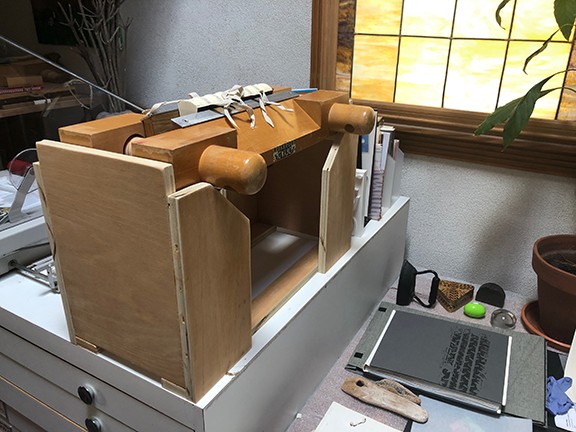Estate sales can be treasure troves for bookbinders. A lucky find and some ingenuity can lead to versatile tools and innovative techniques, especially when it comes to edge decoration. This craftsman’s guide explores how a vintage Dryad Leicester Combination Press, coupled with handmade adaptations, can be used for various bookbinding functions, focusing specifically on edge decoration.
On a rainy weekday, a fellow artist’s suggestion to attend an estate sale proved invaluable. Amidst the bookbinding tools on offer, a Dryad Leicester Combination Press—a combination Plough and Finishing Press—was discovered tucked away in a shed, rescued for a mere $60. This heavy beech workhorse is useful for numerous binding processes.
To further enhance its functionality, a custom “tub” stand was designed. Constructed from leftover oak-veneer plywood, the tub provides space for the book block to hang straight and square under the press, improving access when working on the top side.
Versatility of the Dryad Press
The Dryad press’s strength lies in its versatility. With the finishing (angled) side up, it can secure backing irons with a text block between them, facilitating the backing of a book’s spine after sewing. It also serves as a stable base for sewing headbands or lining the spine. The tub stand elevates the book, reducing strain on the binder’s back.
Flipping the Dryad Press to the plough side—flat with a track for the plough unit—allows for trimming book edges. Although the original plough unit was missing, a sharp Jeff Peachy knife can be used to manually glide over the press rails, cutting the text block clean. The horizontal plough accommodates larger book blocks and is particularly advantageous for books with sewn-on-cord bindings, ensuring square alignment for edge ploughing—a task difficult to achieve on vertical ploughs.
Beyond ploughing, the Dryad press can be used for sanding and painting edges, contributing to a professional and polished look. These edge decoration techniques enhance the aesthetic appeal and longevity of the book.
Handmade Tool Adaptations for Edge Decoration
Bookbinders frequently extend a tool’s usefulness with handmade supports. Inspired by Jana Pullman’s gold tool finishing technique, a custom brass tool holder was created to keep hot brass tools steady on a hotplate.
The tool holder, constructed from scrap wood and metal L-brackets attached with Velcro, accommodates various handle sizes and prevents wooden handles from burning.
Heated brass tools are then applied to the prepared surface for gilding or foil finishing. The Dryad press, on its finishing side, provides support for applying the heated brass tool to foil overlaid on a text block with painted edges.
Maximizing Space and Resources
In a small binding studio, tools with multiple purposes maximize working space and project time. Refurbishing used equipment and adapting tools from scrap materials allows for budget-friendly creativity. Observing other binders’ techniques and thinking creatively helps in the construction of tool adapters. Edge decoration techniques are elevated through resourcefulness and innovative tool usage.
In conclusion, the Dryad Leicester Combination Press, combined with thoughtful adaptations and a craftsman’s ingenuity, is an invaluable asset for bookbinders. It serves multiple functions, especially in edge decoration, from trimming and sanding to painting and foil finishing. By embracing resourcefulness and creativity, bookbinders can enhance their craft and produce exquisite, enduring works. Consider repurposing and adapting existing tools to expand your capabilities in edge decoration and other bookbinding techniques.

